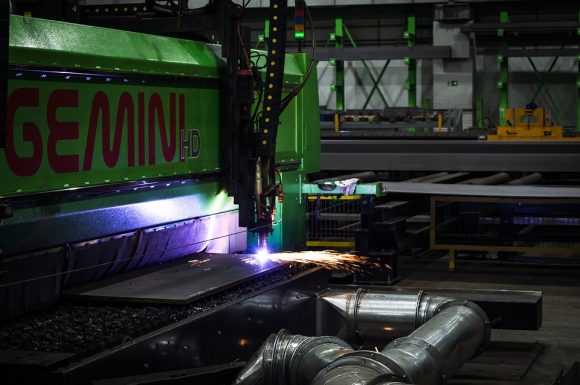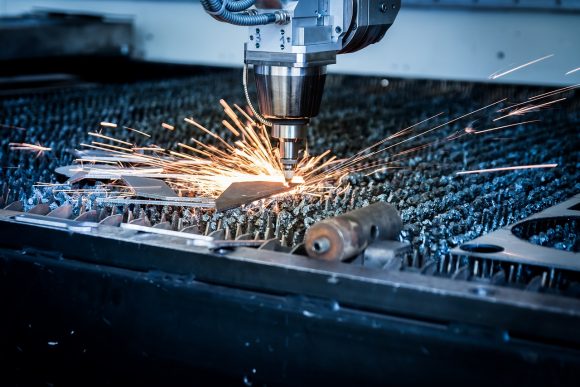The thermal cutting method of plasma cutting uses ionized gas to cut through metal. It is widely used in the manufacturing industry to cut thick metal plates, but it is also used for cutting sheet metal.
Plasma cutting developed out of plasma welding in the 1960s. But it only became a productive metal-cutting process in the 1980s. The first plasma cutting machines were large, slow, and costly. Therefore, they were typically only used for repeatable cutting patterns in mass production. But when Computer Numerical Control technology was used in plasma cutting in the late 1980s and early 1990s, plasma cutting machines became much more flexible. They could cut different shapes based on the instructions programmed into the machine’s numerical control. In the last decade, plasma cutting machine manufacturers have devised completely new models that have a smaller nozzle and a thinner plasma arc, which allows for greater precision and does not produce metal chips.
How exactly does plasma cutting work?
In plasma cutting, electrically conductive materials are cut via an accelerated hot jet of plasma. The machines are used to cut steel, stainless steel, brass, copper, aluminum, and other conductive metals. The conductive gas used in plasma cutting reaches temperatures of up to 30,000° Celsius.
The basic process involves creating an electrical channel of superheated, electrically ionized gas from the plasma cutter to the workpiece that requires cutting. An earth terminal creates a finished circuit back to the plasma cutter. Compressed gas is blown through a nozzle to a workpiece at high speed. An arc then forms in the gas, between an electrode next to the gas nozzle and the workpiece. The arc ionizes part of the gas to create an electrically conductive plasma channel. When the current from the cutting tool flows through the plasma, it emits enough heat to melt a workpiece. At the same time, the hot molten metal is blown away, separating the workpiece.
Where to Buy Plasma Cutting Machines
If you are looking to use plasma cutting machines for manufacturing, you can find a variety of superb reconditioned plasma machines at Revelation Machinery. Reconditioned machines are less expensive than new machines, and the inventory at Revelation Machinery includes a wide variety of lengths, capacities, and brands. You will find machines by leading brands such as Messer, Hypertherm, and Hornet.
Applications of Plasma Cutting
The applications and functions of plasma cutting are widespread. In addition to being used in the general manufacturing industry, plasma cutting machines are used in sectors like industrial construction, agricultural maintenance, and automotive repair and restoration. The machines are also used by metal service centers, welding repair centers, the commercial shipbuilding sector, trailer production, and sculpture.
The Cutting Process
Not all plasma cutting works in the same way. One method is called high-frequency contact. However, it is a low-budget plasma cutting option and is not suitable for CNC plasma cutters because the high frequency can disrupt modern equipment and create issues. The method uses a high voltage and high-frequency spark, which is created when the plasma torch touches the metal.
Another method is called the pilot arc method. The spark is created inside the plasma torch by a low current circuit and a high voltage, creating the pilot arc. The cutting arc is created when the pilot arc makes contact with the workpiece.
Using a spring-loaded plasma torch head is another option. By pressing a plasma torch against a workpiece, a short circuit is created to make the current begin to flow. The pilot arc is created by releasing the pressure, bringing the arc into contact with the workpiece.
The Pros and Cons of Plasma Cutting Machines
There are many advantages to using plasma cutting machines in manufacturing, but there are some disadvantages too. For example, the quality of cutting thin sheets and plates is not as good as laser cutting, and the tolerances are not as precise as they are with laser cutting. Also, plasma cutting does not reach the thickness you can attain from using waterjet or flame cutting. On the other hand, the advantages include:
- Being able to cut all conductive materials.
- Being able to achieve excellent quality for thicknesses up to 150 mm.
- Being the best method for cutting thick aluminium and stainless steel.
- Being able to cut in water.
- Having a quicker cutting speed than oxyfuel.


1 Comment
Co.in